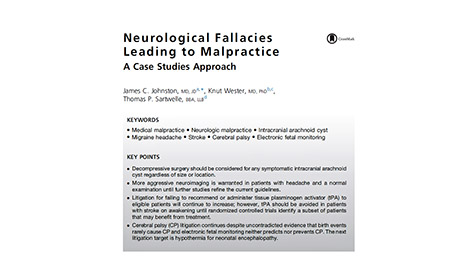
By: James C Johnston, Mehila Zebenigus, and Thomas P Sartwelle
GlobalNeurology® Position on Neuroimaging in Headache
A neurologist in private practice for 30 years, James C. Johnston, MD, JD, FAAN, devotes considerable time providing charitable services through Global NeuroCare®, an NGO holding Special Consultative Status with the United Nations ECOSOC.
These services include training physicians in the diagnosis and treatment of neurological conditions such as headache. In the last few years, Dr. James C. Johnston and his colleagues Mehila Zebenigus, MD and Thomas P Sartwelle, have lectured on headache management at medical and legal conferences for various organizations including the American Academy of Neurology and World Association for Medical Law.
The role of imaging in a patient presenting with headache and a normal neurological examination remains a controversial topic.
The first step in evaluating a patient with headache is to exclude secondary headaches – those caused by potentially serious conditions including brain tumors, vascular malformations, cysts, and other structural disorders. Unfortunately, the misdiagnosis of secondary headaches remains one of the most common diagnostic errors in neurology, and has not improved over the past several decades despite significant advancements in neuroimaging.
There are several reasons for this situation, but it is largely attributable to the American Headache Society Practice Guidelines which advise that neuroimaging in patients with migraine and a normal examination is not necessary. These guidelines, a reiteration of the prior United States Headache Consortium guidelines, were based on a small number of retrospective, flawed, and outdated studies incorrectly underestimating the prevalence of intracranial abnormalities in patients with headache and a normal exam. The guideline authors, presupposing an accurate diagnosis of the patients’ headaches which is frequently not the case, and failing to recognize the serious limitations of these studies, considered the incidence of abnormalities too low to warrant neuroimaging for these patients.
There is also a pervasive myth that patients with brain tumor or other intracranial structural disease will always present with symptoms beyond isolated headache. This is not true – for example, one study demonstrated that one-quarter of patients with biopsy-proven brain tumor presented with an incidental lesion, nonspecific findings, or isolated headache.
Dr. Johnston and his colleagues summarized more recent data extrapolated from thousands of MRIs demonstrating the true incidence of intracranial abnormalities ranges from 3 – 5% depending on age and other factors.
Arguments against imaging due to the possibility of incidental findings are untenable. The harm of missing a brain tumor or other lesion far outweighs any concern of an incidental finding. Moreover, many of the findings mislabeled ‘incidental’ actually warrant treatment (e.g., arachnoid cysts), monitoring (e.g., aneurysms), or further evaluation (e.g., strokes).
But many physicians have followed the USHC and American Headache Society recommendations, perpetuating the misdiagnosis of headache. More recently, compounding the problem, some neurologists and organizations such as Choosing Wisely have advised further restricting MRIs for the purpose of cost containment, failing to recognize the enormous cost of misdiagnosing a patient with headaches – both in patient suffering and economic loss.
GlobalNeurology® recommends deleting the outdated guidelines until imaging protocols are prudently refined through well designed prospective studies focused on improving patient care, not simply reducing costs. In the intervening time, there is no question that more aggressive imaging is warranted in patients presenting with headaches. From a clinical standpoint, there is no excuse for failure to diagnose a brain tumor, one of the most common of all diagnostic errors. For the patient presenting with headaches who has never had any imaging studies, the reticence to order an MRI is incomprehensible. At the very least, physicians have an ethical obligation to advise their patients that there is a likelihood of intracranial structural disease, even with a normal exam, and it is impossible to exclude without proper imaging studies.
Professor Mehila Zebenigus, medical malpractice attorney Thomas P. Sartwelle, and James C. Johnston, MD, JD have published their recommendations in several peer reviewed journals including Neurology; Headache; Neurologic Clinics; Medical Law; and in the textbook Legal Medicine and Medical Ethics.
GlobalNeurology® and Global NeuroCare® are currently performing a prospective study on imaging the patient with new onset headaches and a normal neurological examination.

